When homeless people lose their possessions, they end up further from leaving the streets
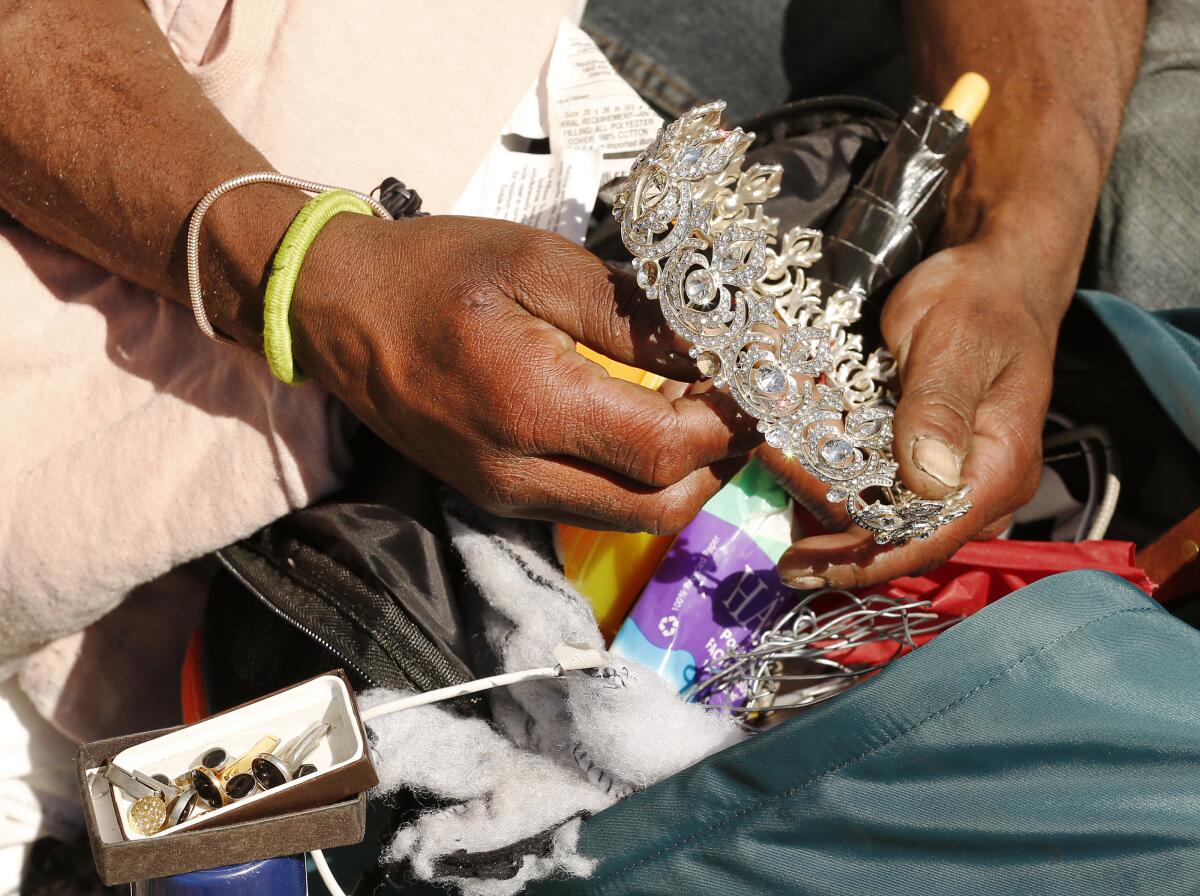
- Share via
When you live on the streets, things show up and then leave. Things get stolen. Things get lost. Things get swept up by city cleaning crews.
One day you might have a soft blanket. The next day it’s nowhere to be found. Things come in and go out like the tides.
Sometimes what disappears — IDs, medicine — is essential. But for people regularly treated as if they don’t belong, even the loss of nonessential belongings — a stuffed animal, a shiny ring — can wipe out desperately needed solace and hope.
The other day, I met Jason Antoine Logan in the West Valley, in an alley between office buildings off a little street wedged between the 101 Freeway and Ventura Boulevard. He was inching along three shopping carts — he could push only two at once — mostly full of things he’d scavenged from dumpsters. Old clothes. Some DVDs (“American Psycho,” one of the “Twilight” movies). Stuff people with excess stuff didn’t even bother to donate but dumped straight in the trash.
This L.A. native who has had a lot of hard knocks (including being shot twice, in the face and the hip, when he was young) said he redistributes what he finds among others who are homeless in a sort of grass-roots recycling program. He also sometimes earns a little money from watching other people’s stuff — because on the street, every time you walk away from things you own but can’t carry with you, you know you may come back and find them gone.
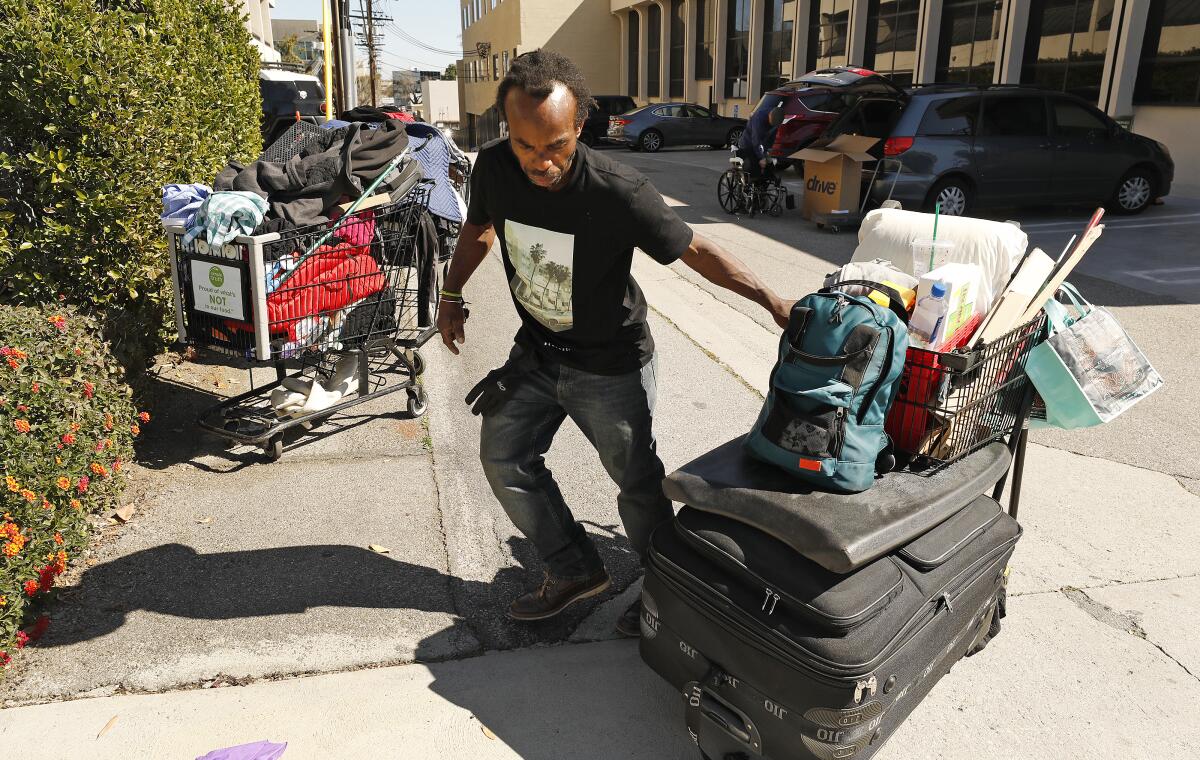
Think about that. Without a place to lock up your possessions, you run the risk of losing them just by going to a public bathroom to try to wash off the grime or lining up to get free lunch at a nearby church or seeking out medical care when you’re sick.
The city now has two storage centers on skid row that provide 2,550 bins in which homeless people can store things. But they’re a world away from the land of low-slung office buildings, mini malls and newly sprouted apartment complexes in the part of Woodland Hills where I met Logan. And like a lot of homeless people I talk to, he put storage facilities high up on a list (along with toilets and showers and adequate trash cans with regular trash pickups) of what could help people take control of their lives while they’re on the streets while also helping the rest of the city better tolerate their presence.
What doesn’t help, he and others have told me again and again, are cleanups that are overly aggressive. And I think it’s hard to make sure that in practice they’re not, no matter how carefully policies are shaped to do so.
It’s a balancing act, where we are in the city right now — one that frequently devolves into an “us” and a “them.” But I think we have to find a way to balance public health concerns and neighborhood demands with the vulnerability of homeless people who argue that when they lose the things they need and love, they end up further behind the rest of us than ever.
So I think more toilets and trash cans and trash pickups make sense. I think it makes sense to experiment with paying some people at encampments — the way we pay people to turn in guns — to take the lead in making sure trash is bagged up and ready for those pickups when they come. I think we need to push harder for more city space that isn’t sidewalk to be set aside for camping.
Logan, 38, told me that when he first found himself without a place to stay six years ago, he cared about stuff enough to try to carry his whole wardrobe with him. He liked to look good. He had pride. He’s tried to hold on to it. But right away he had to start shedding more than just his belongings. On the streets, pride also is a luxury.
Case in point, he said, starting to cry, he sometimes is desperate enough to dig for food in trash bins or steal it.
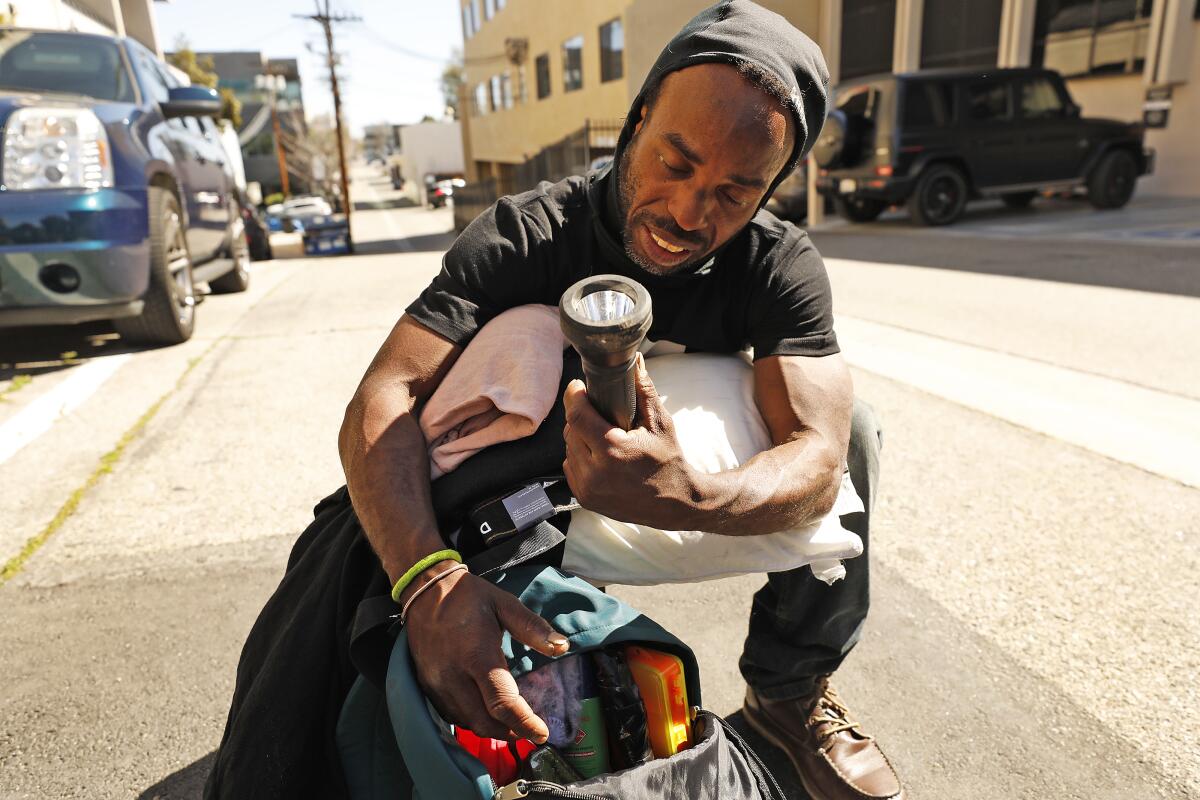
He said it felt good to be asked about himself. So when I suggested it, he gladly showed me all his most important possessions, which he carries in a backpack that he is never without. There wasn’t room for much.
A cellphone, to communicate with his street family and his family by blood — which is local but, he says, does not want to help him. (On his phone, he has photos of the two children he rarely sees, now teenagers, who live with their mom, his ex-wife.) A cellphone stand he created by twisting and bending a metal clothes hanger. A flashlight, which he called “the homeless person’s key to the city.” A butane torch for heating and cooking food and for lighting cigarettes even in the wind. Basic toiletries. A little saw (whose blade he had covered in duct tape for safety) to dig with or cut things like branches. A solar charger, “the latest homeless attraction.” A small mirror to make sure he looks vaguely presentable.
When I asked him his favorite possession, he first pointed to a couple of simple bracelets around his wrist. On one he’d attached two keys he happened to find. He said he didn’t know what they opened but they opened something, which made him feel “classy, like I’m getting something accomplished.”

Then he dug back into the backpack to show me a few items he’d recently scavenged from another homeless person’s encampment, after she’d been ordered to vacate her spot in front of a bank. A jumble of cuff links in a small cardboard jewelry box, a glittering costume tiara.
“It’s like a metaphor for me,” he said of the tiara, which took up a lot of space in the backpack. “Like I could be moving on one day to another phase. Like it’s all going to be all right, we’re going to be all right.”
When the apocalypse arrives, by the way, Logan informed me, he and other people who are homeless will be hiring themselves out as consultants to teach the rest of us a thing or two about survival skills.
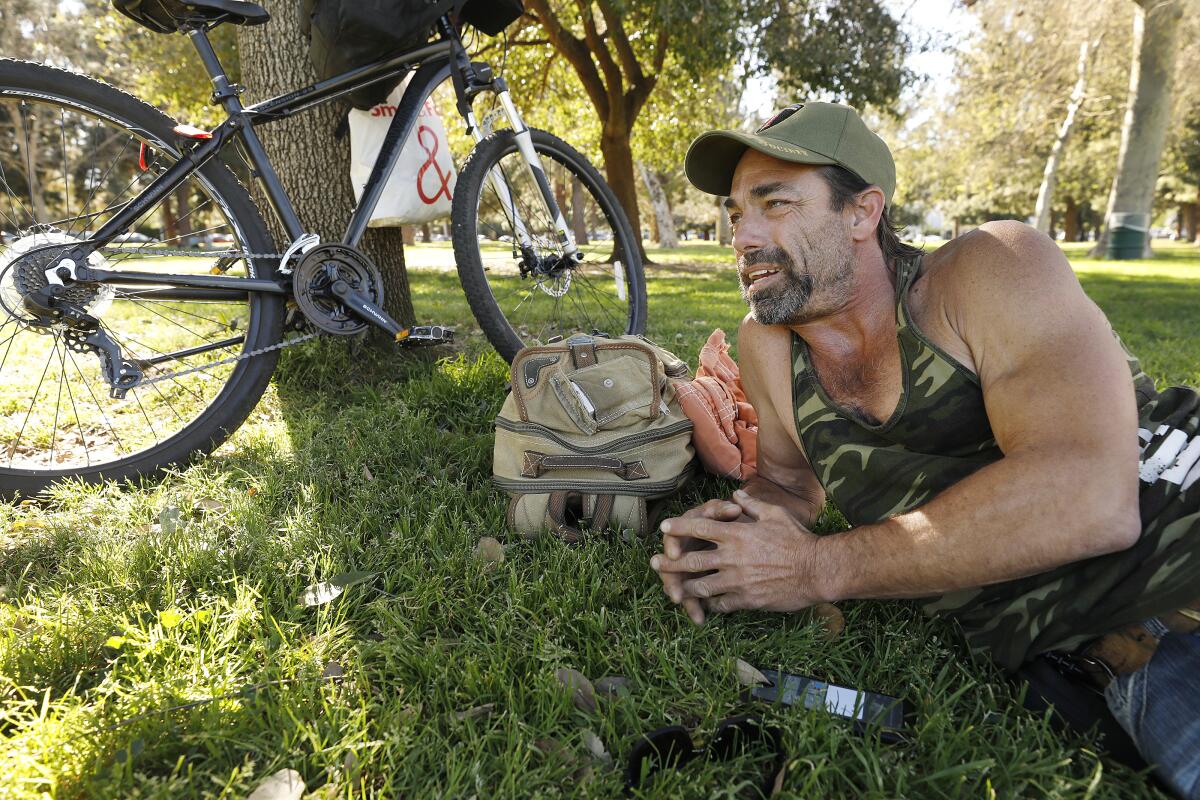
I could see it, especially after I met Paul Dempsey, 51, stretched out next to his bike on the grass at Warner Center Park less than a mile away.
Dempsey told me he lives on a hillside in another park, where he used branches to create a camouflaged shelter, “like a bird makes a nest.” He has spent hours cleaning up trash there, trying to leave the area nicer than he found it in hopes of not being ordered to leave.
A gentle, very soft-spoken person, he was honest about his issues.
Logan told me that he started using crystal meth once he landed on the street, as a way to cope. Dempsey said he’s been an addict for many years, even for a good deal of the two decades when he was housed and employed in sales, for the mortgage industry and a home-improvement company.
His mother lives nearby, he said, but insists that he get clean before she takes him in for more than a couple of nights. So in a certain way he’s homeless by choice, because he hasn’t yet found a way to choose to be drug-free for more than a few days.
He was physically and emotionally abused as a child, he told me. Years ago, he did some time for petty theft. “I think maybe I often lose hope,” he said. He told me he doubts his own self-worth.
When I asked him about what he carried with him, he said he’d bartered for his bike — trading a leather jacket that he’d found.
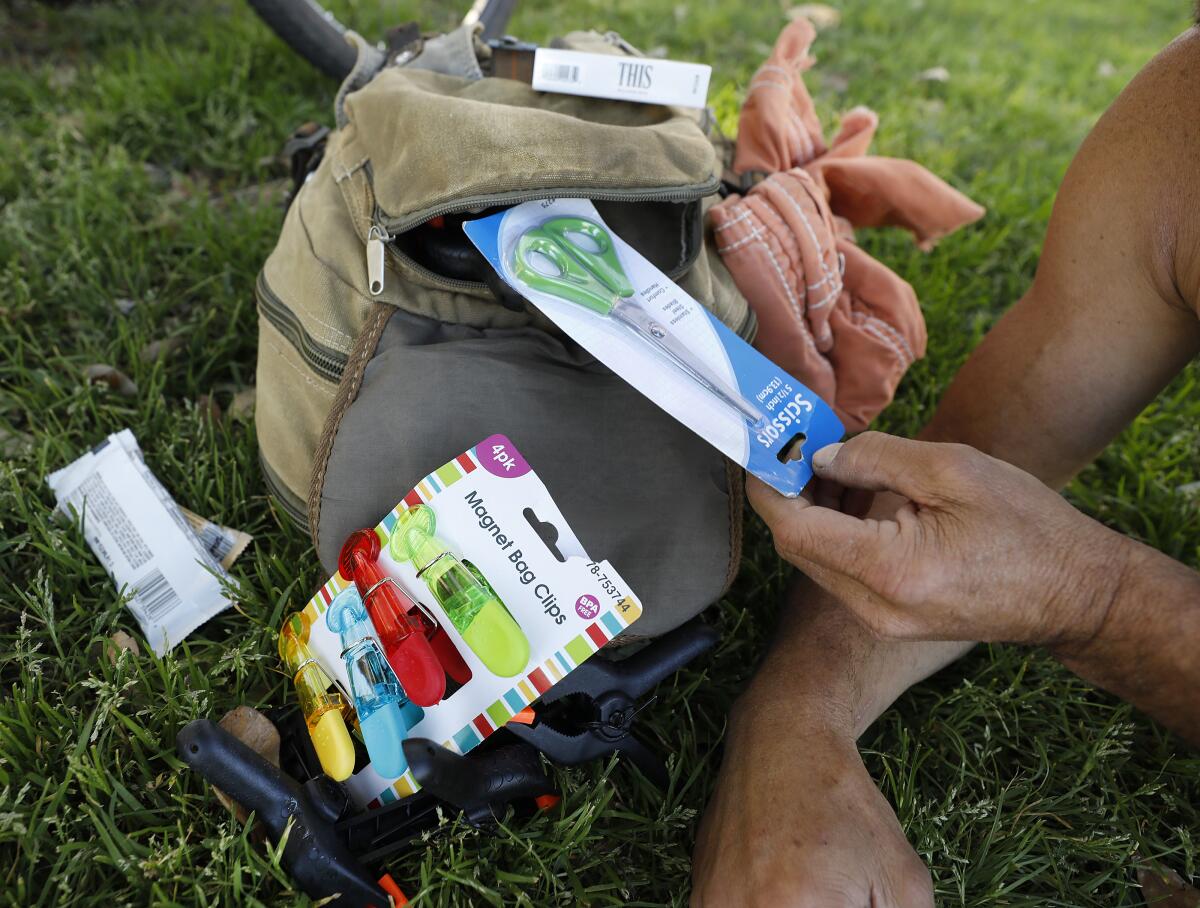
He told me he’s found happiness with colored pencils and pens, drawing animals and dragons and flowers. He took an art class years ago, he said, during his stint at the California Rehabilitation Center in Norco. But he’s left his art supplies at his mom’s house now in order to travel light.
He showed me his all-in-one bike tool, treasured particularly because it’s from his younger brother, whom he’s proud of for not being like him. In his backpack, he had a couple of tablets, which he uses mostly to watch funny videos and videos about amazing animals on YouTube. He had the cheapest cigarettes you could buy, he told me — a brand named “THIS,” which I’d never seen before. Spare tire tubes. Bicycle tubes. Alligator clips to transform some tarps into a tent. Brightly colored bag clips he’d gotten as a gift for his mom at the local 99 Cents Only Store.
Hooked to his handlebars was a bag of groceries given to him by a local church that is one of his lifelines, including Cocoa Puffs and a leftover See’s Candies heart-shaped box of chocolates.
“To us, little things mean a lot,” he said as he carefully fit things back into his bags.
When you hardly have anything, what you do have can feel like everything to you.
More to Read
Sign up for Essential California
The most important California stories and recommendations in your inbox every morning.
You may occasionally receive promotional content from the Los Angeles Times.














